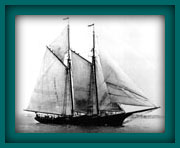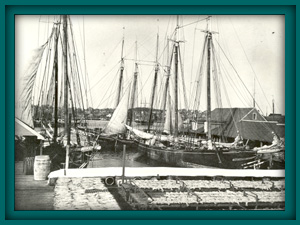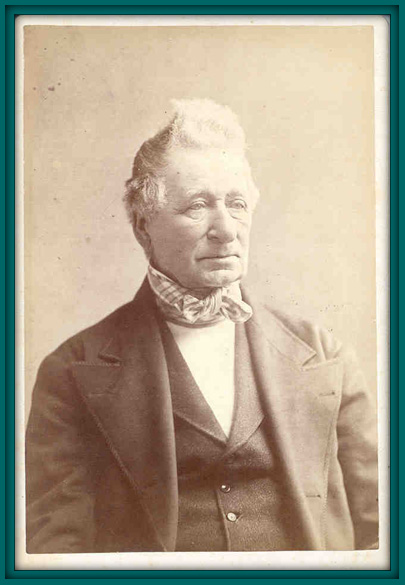|
 On
February 5, 1894, a single line of print in a corner of
the Gloucester Daily Times recorded an addition to the
Gloucester, Massachusetts fishing fleet: "The new
schooner for J.F. Wonson and Co. has been named Effie M.
Morrissey." This marked the commonplace birth of a
schooner that would become famous not only as a banks
fisherman, but also as one of the great expedition
vessels of arctic exploration, a venerable transAtlantic
immigration packet, a symbol of Cape Verdean-American
history and heritage, and as an active educational and
cultural resource serving the New England region.
However, the white oak and yellow pine hull of the Effie
M. Morrissey slid down the ways of the John
F. James & Washington Tarr shipyard not as remarkable individual ship, but as a fine
example of thousands of similar, Essex-built schooners.
It was the heyday of the Gloucester fisherman. On
February 5, 1894, a single line of print in a corner of
the Gloucester Daily Times recorded an addition to the
Gloucester, Massachusetts fishing fleet: "The new
schooner for J.F. Wonson and Co. has been named Effie M.
Morrissey." This marked the commonplace birth of a
schooner that would become famous not only as a banks
fisherman, but also as one of the great expedition
vessels of arctic exploration, a venerable transAtlantic
immigration packet, a symbol of Cape Verdean-American
history and heritage, and as an active educational and
cultural resource serving the New England region.
However, the white oak and yellow pine hull of the Effie
M. Morrissey slid down the ways of the John
F. James & Washington Tarr shipyard not as remarkable individual ship, but as a fine
example of thousands of similar, Essex-built schooners.
It was the heyday of the Gloucester fisherman.
 The
contract price was $6,700 for hull and spars, ready for rigging. The
Effie M. Morrissey was the last fishing schooner built for the Wonson
Fish Company.
She took four months to build and was launched February 1, than
towed by the tug Startle to Gloucester, the Morrissey was
fitted out for the season to go salt cod fishing The
contract price was $6,700 for hull and spars, ready for rigging. The
Effie M. Morrissey was the last fishing schooner built for the Wonson
Fish Company.
She took four months to build and was launched February 1, than
towed by the tug Startle to Gloucester, the Morrissey was
fitted out for the season to go salt cod fishing
George McClain of Gloucester was one of the pioneer
designers of a new type of fishing schooner whose fine
lines offered extra speed to market for the best price
and a deep, heavily ballasted hull for stability to
withstand North Atlantic gales. McClain, a former
schooner skipper and prominent public figure in
Gloucester during the 1890s, designed the 112' Morrissey
with a 13' draft and 8,500 square feet of sail.
Ernestina’s one hundred years of active service
attest to the quality of the McClain model.
THE FISHING WONSONS
Submitted by Robert E.
Viator
Walnut Creek, California
John F. Wonson's great, great grandson
 Here is a photo of John Fletcher Wonson (1802 -
1867), founder of John F. Wonson & Company of East
Gloucester. Besides founding the company that bore his
name, he was chiefly famous as the fisherman who
established the winter halibut fishery on Georges Bank. Here is a photo of John Fletcher Wonson (1802 -
1867), founder of John F. Wonson & Company of East
Gloucester. Besides founding the company that bore his
name, he was chiefly famous as the fisherman who
established the winter halibut fishery on Georges Bank.
Prior to 1830, common
wisdom held that any vessel that anchored on Georges in
winter--when wicked tides race over the shoal--was in
danger of exceeding hull speed and being "drored
under". In March 1830, John Fletcher Wonson
anchored the family schooner Nautilus on Georges
and fished up 20 enormous halibut, which he brought into
Gloucester. Thereafter, winter halibut became a staple of
the new fresh fish business, supplementing the ancient
salt cod business.
John began fishing with
his father, Samuel Wonson (1773 - 1850). Samuel was a
principal in Giles & Wonson and later Samuel Wonson
& Sons. About 1832, when Samuel retired from
the sea to become the first keeper of the Eastern Point
lighthouse, John had a parting of the ways with his
older brother, also named Samuel, and set up in business
for himself. The heyday of John F. Wonson & Company
was after John's death, under the entrepreneurship of
three of John's sons: Frederick Giles Wonson (1829
-1919), Roger Williams Wonson (1834 -1920), and Franklin
Augustus Wonson (1846 -1903). In 1894, when the
company had the Effie M. Morrissey built, she was
one of seventeen schooners sailing under the John F.
Wonson flag. In 1905, following the death of
Franklin Augustus Wonson, the company sold off its
vessels and dockside assets and became mainly a fish
specialty marketing operation under the direction of
Frederick Giles Wonson's son, "Charlie
Fred" (1859 -1936).
|